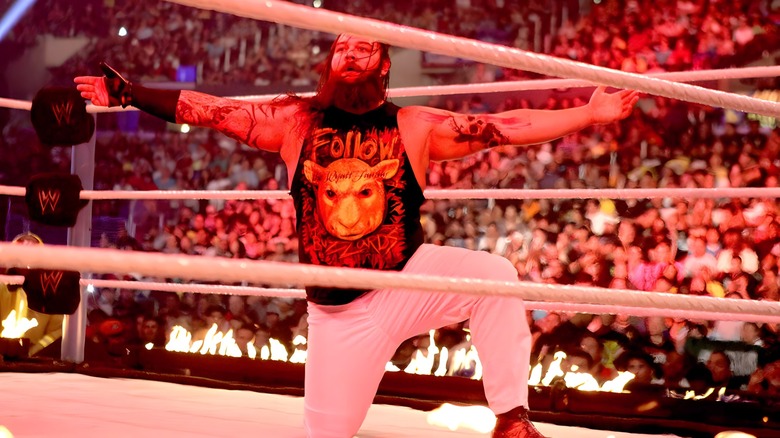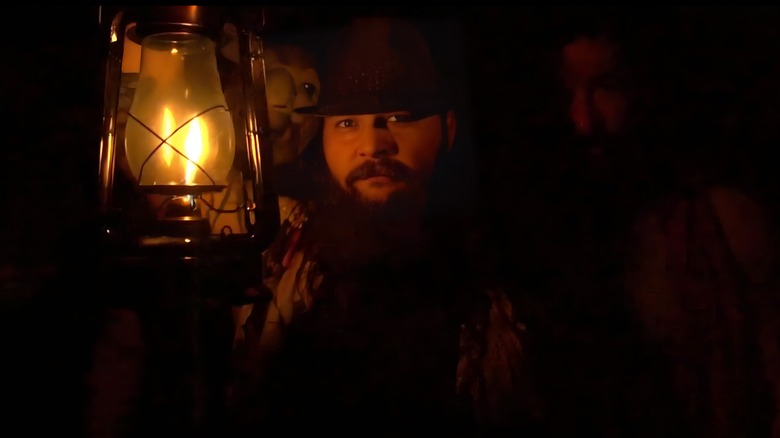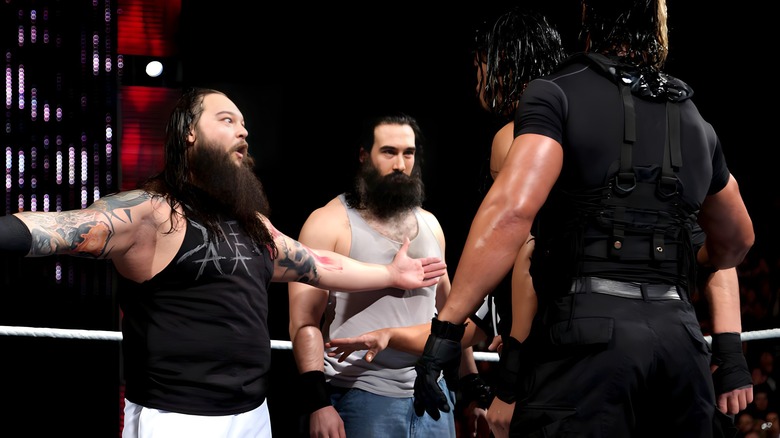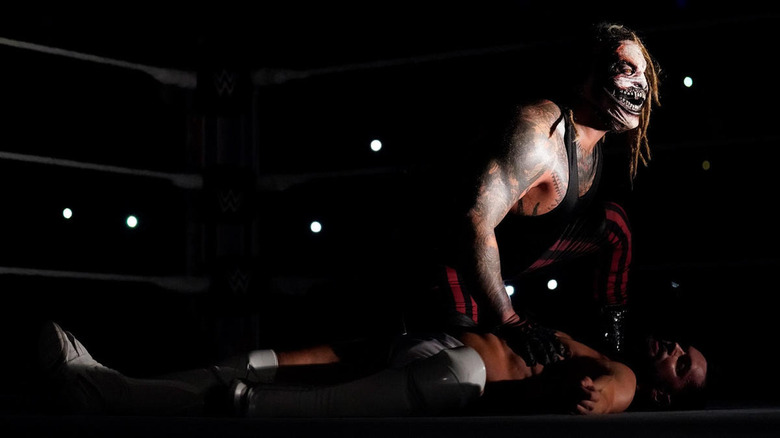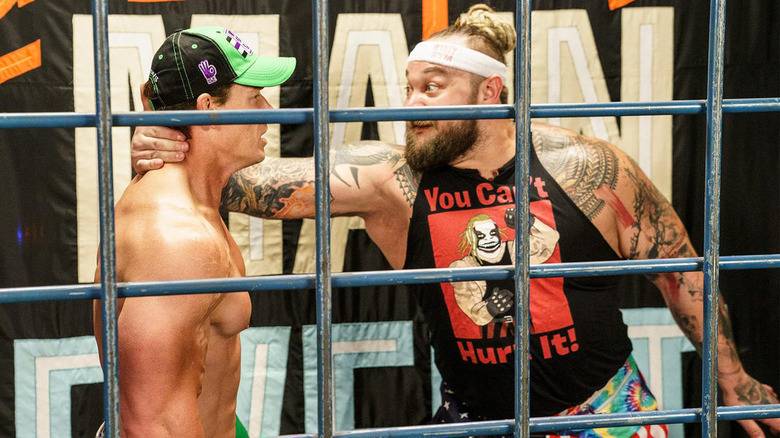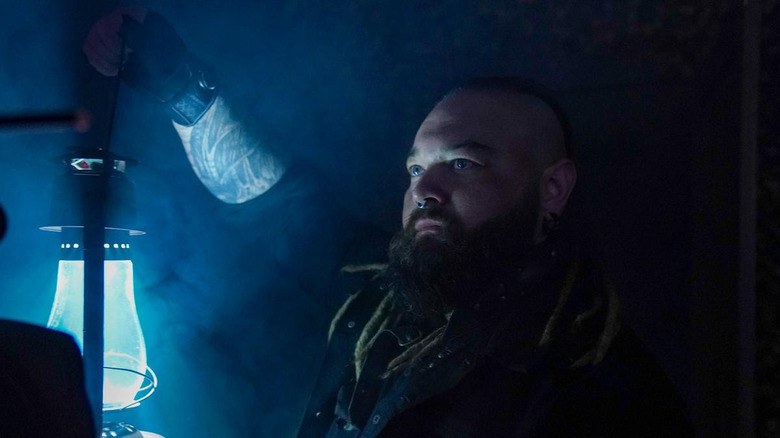Bray Wyatt's 5 Best Moments In WWE
This week has seen the wrestling world rocked as hard as it's ever been rocked in recent memory. Wrestling fans hadn't even finished mourning the death of one of the industry's greatest legends, Terry Funk, on Wednesday, before Thursday brought something even more tragic: the death of Windham Rotunda, aka Bray Wyatt, who was only 36 years old. He had seemingly only just begun the next part of his story when he was struck down by illness just before WrestleMania 39; now that story will never be written, and we are left to consider Rotunda, one of WWE's most compelling performers, and Wyatt, one of the company's most flawed but fascinating characters, a case study in fictional destruction and rebirth.
Rotunda's career is worth exploring in detail for its intricacies, its twists and turns, its passionate successes and heartbreaking failures, but that's a project for sometime down the road, when the terrible wound of his early passing has been covered by at least a thin layer of scar tissue. For now, we celebrate Rotunda by celebrating the high points of his WWE career. With another wrestler, this might be an article about his greatest matches, and there will be some matches here. But Bray Wyatt was a creature of moments, a character built more from lights and music and sheer presence than from headlocks and suplexes. As a result, we present here Wyatt's five greatest moments in WWE.
The Wyatt Family debuts, WWE Raw, 7/8/13
The Bray Wyatt character was formally born on an episode of "WWE NXT" that aired on July 11, 2012, but it would be some time before the wrestling world at large would know his name. That's because 2012 and early 2013 were the nascent stages of what we know today as "NXT," which at the time was just a repackaged version of WWE developmental promotion Florida Championship Wrestling. Later in 2013, matches put on by early "NXT" stars like Sami Zayn and Paige (now known as AEW's Saraya) put the promotion on the map, and its availability as part of the new WWE Network in 2014 made it accessible to a vast new audience, but WWE fans already knew who Bray Wyatt was by then. After weeks of video packages full of creepy imagery and disturbing Wyatt monologues, Wyatt and his Family (Erick Rowan and the late Brodie Lee, known at the time as Luke Harper) debuted on the July 8, 2013 episode of "WWE Raw," almost a year to the day after he debuted on "NXT."
Wyatt had spent his first year refining his character, trying out new things, figuring out where the balance lay between evil preacher and silver-tongued cult leader, between "Cape Fear" villain and literal Antichrist (in one early episode of "NXT," he speaks in tongues). By the time he and the Family arrived on "Raw" and laid waste to Kane, the character had been refined, and its most important elements were all there: the lantern, the rocking chair, and the way he spoke. We dare you to watch Bray light his lantern and announce "We're here" for the first time without chills running down your spine.
The Wyatt Family vs. The Shield, Elimination Chamber 2014
Ask a longtime WWE fan for Bray Wyatt's best match, and most of them will probably come up with the same one: February 2014, Elimination Chamber, The Wyatt Family vs. The Shield in a six-man tag team contest. It's a fitting choice in a number of ways. It's early in Wyatt's career, before the roller coaster he was about to experience in terms of his booking and his creative — it would be more than five years before his character was again as hot as he was at the start of 2014. It's a large match, involving five other wrestlers — the Bray Wyatt character was fundamentally communal, always at its best when functioning in relation to others. He rarely worked in singles matches; he thrived in tag teams, in stables, anything that allowed him to relate to and revolve around others.
And of course, there were those other five wrestlers in particular — Harper and Rowan, of course, but on the other side of the ring, the force of nature known as The Shield: Dean Ambrose (now AEW's Jon Moxley), Seth Rollins, and Roman Reigns, not just three future world champions, but three future "biggest stars in the business."
If you haven't revisited this one in a while, we can't recommend it highly enough. It was a unique time — both factions, despite being nominal heels, were enjoying a massive swell of support from a 2014 WWE audience that was in the middle of the Yes! Movement and was fully prepared to demand WWE push the wrestlers they wanted WWE to push. The crowd didn't really care which team won, they just wanted them to fight each other for as long as possible and drink in every second, and WWE, for once, gave it to them. It's 22 minutes of full-throated audience-endorsed combat, and there's an argument to be made that it remains Bray Wyatt's peak.
The Fiend debuts, SummerSlam 2019
There's a reason we're jumping from 2014 to 2019: the years in between weren't the kindest to Bray Wyatt, who preached revolution against the crushing machine of WWE, but who, as a character within that machine, was ultimately powerless to resist being crushed. His loss to John Cena at Wrestlemania 30 sent him on a downward spiral from which he could only recover by reinventing himself, time and time again, always having to go back to the drawing board after his latest defeat. By the time 2019 rolled around, things had gotten rough; Wyatt had settled far closer to the bottom of WWE's hierarchy than the top, with even his tag team with Matt Hardy being shot down by WWE creative.
So what did he do? He re-invented himself again, of course, this time in the strangest way possible: by becoming the quirky host of the Firefly Funhouse, a show-within-the-show that was ostensibly for children, but that allowed Wyatt to express his frustrations with his career to that point. And it came with a major twist in the form of Wyatt's new alter ego, The Fiend, whose entrance for his debut match against Finn Balor at SummerSlam 2019 has to be seen to be believed. Who else comes out holding a lantern literally made from the head of the character's previous incarnation?
Of course, The Fiend famously did not turn out to be Wyatt's ticket to fame and fortune — whether you blame WWE or Wyatt himself, the character ultimately tanked creatively like all the others, finally culminating in Wyatt's 2021 firing. But that SummerSlam debut? That was a moment.
Bray Wyatt vs. John Cena, Firefly Funhouse Match, WrestleMania 36
It is so, so painfully ironic that the peak of Bray Wyatt's creativity as a character came in 2020, at the beginning of a global pandemic that would see millions die from the disease that would eventually lead to Rotunda's death, as well.
WrestleMania 36 arrived shortly after the onset of the COVID-19 pandemic. It took place in an empty arena, with no fans present. As a result, it's a WrestleMania event that's almost entirely unwatchable, aside from the two cinematic matches on the card. Was the Firefly Funhouse match between Bray Wyatt and John Cena originally meant to be cinematic in nature? We're not sure, but it ended up being the perfect environment for a character like Wyatt, who could finally play outside the restrictions of the ring and the ropes. Together, Wyatt and Cena crafted a wrestling story that some hated and others loved, but that was undeniably fascinating, a story that played on all their prior history and ended with Wyatt, at last, getting the victory over his old nemesis, accomplishing in this murky world of dreams and nightmares what he was never able to accomplish by the bright light of day. It's an utterly fascinating artifact, and whether you despise it to your core or think it should have won awards, chances are that you've never, ever forgotten it. If Elimination Chamber 2014 was Bray Wyatt's best conventional match, WrestleMania 36 was Wyatt at the true peak of his powers, which could only be achieved by transcending wrestling itself.
Bray Wyatt returns to WWE, Extreme Rules 2022
At the time, it was the culmination of the bizarre and intricate "white rabbit" story, the triumphant return of one of WWE's darkest prodigal sons. Now, looking back, it's a glimpse of potential that was ultimately wasted, a perfect and terrible reminder of everything we've now lost.
Rumors abounded heading into Extreme Rules 2022 that the event would feature Wyatt's return, which was the culmination of the white rabbit hints that had been dropped across WWE programming for weeks leading up to the show. Still, it was one thing to hope for Wyatt's return, and another thing to receive it. The PLE-closing segment contains all the seeds of the things we will never get to see: the rumored Wyatt 6 stable, personified by real-life versions of the Firefly Funhouse puppets that appeared in the crowd; the return of the classic Wyatt character, which didn't exactly turn out the way we expected; the general excitement for a Wyatt storyline presided over by someone other than Vince McMahon, which turned out to be a slow-burning disappointment that went out with a whimper at the 2023 Royal Rumble — the notorious Mountain Dew Pitch Black match wasn't the last one of Wyatt's career, but it might as well have been.
That was Bray Wyatt, in a nutshell: Potential. An unending flow of passionate creative energy that never found the right story to channel it. It might be true that Windham Rotunda's roads all eventually led to the same dark and tragic place, but tonight, in the wake of his passing, we choose to remember the hope rather than the despair, the beginnings and not the ends — the moments where, as he entreated us to do in his very first "NXT" promo, we believed in Bray Wyatt.
